When you think of classic and elegant jewelry, you probably think of pearls right away. You might be surprised to learn that not all pearls are the same. There are many different types of pearls that are very interesting! Every kind of pearl has its own story.
Let’s look into this interesting world of pearls. If you love jewelry, collect it, or are just thinking about buying your first pearl, knowing the differences will help you pick something you’ll love and treasure for years.
Understanding the Foundation: Natural vs Cultured pearls
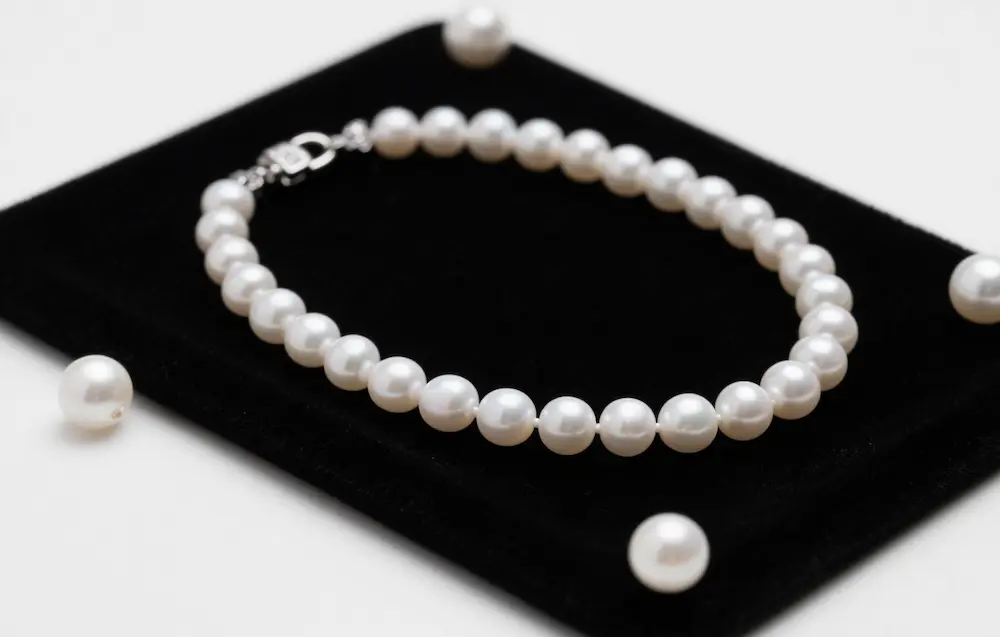
Before we talk about the different types of pearls, it’s important to know the main difference between natural and cultured pearls. When a small irritant gets into a mollusk, like an oyster or mussel, it makes a natural pearl. The mollusk then starts to cover the irritant with layers of nacre, which is what makes the pearl. These natural pearls are very rare and can take a long time to form on their own.
We help make cultured pearls, on the other hand. A small bead or piece of shell (called a nucleus) is carefully put inside the mollusk by someone who knows what they’re doing. Just like with a real pearl, the mollusk starts to cover this nucleus with nacre. This doesn’t change the fact that the pearls are “real.” They are still real pearls, with the same beautiful shine and made of the same material as natural pearls.
The cultured pearl industry has really changed things, making these beautiful gems more accessible to everyone. Nowadays, most of the pearls you see for sale are cultured, and they can be absolutely stunning examples of the different types of pearls out there.
The Great Divide: Freshwater vs. Saltwater Pearls
Okay, so the world of pearls is basically divided into two main groups, depending on where they’re grown: freshwater and saltwater. This difference really affects their look and feel.
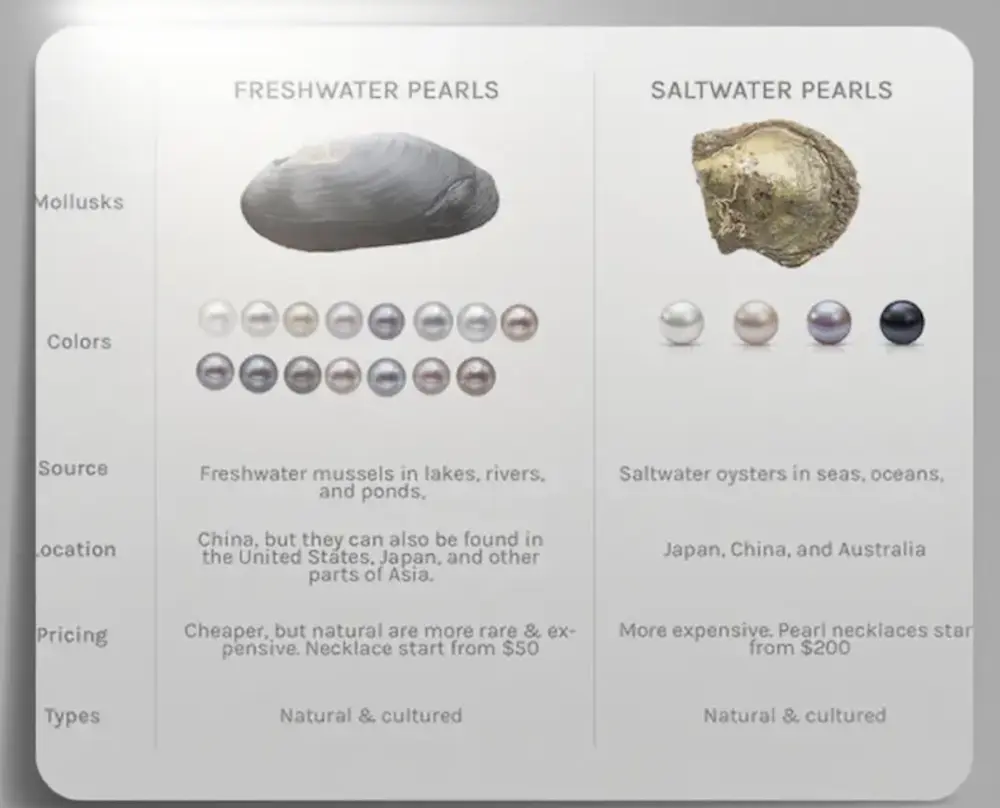
Freshwater Pearls: Nature’s Versatile Gems
Freshwater pearls are grown in mussels that live in rivers, lakes, and ponds, and they are among the different types of pearls that delight collectors. China is the biggest producer of these pearls, although they’re also farmed in Japan and the US. What’s really cool about freshwater pearls is that they come in an amazing range of shapes, sizes, and colors.
These pearls are usually between 2mm and 15mm across, but most are in the 6mm to 10mm range. They come in beautiful colors on their own, from the classic white and cream to soft pastels like pink, lavender, and peach. You can even find some that are harder to find in darker shades of purple, gold, and bronze.
Among the different types of pearls, one of the best things about freshwater pearls is that they cost less than saltwater pearls. They are a great choice for all kinds of jewelry, from simple pieces you wear every day to really fancy pearl necklaces that catch the eye.
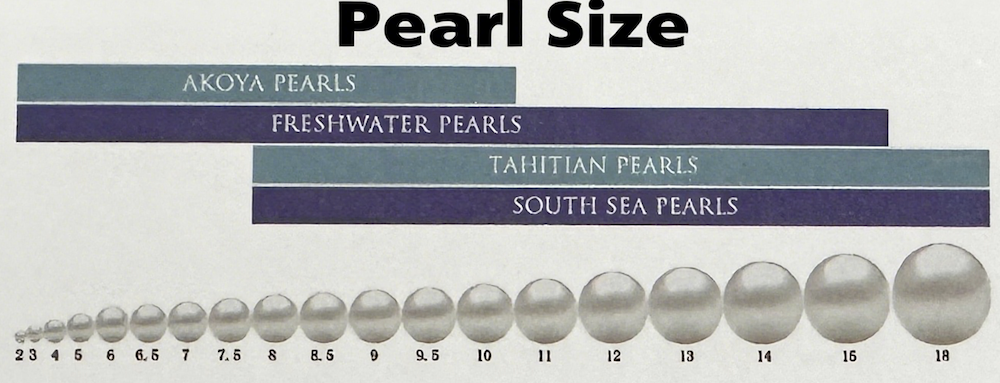
| Pearl Characteristic | Freshwater Pearls | Saltwater Pearls |
|---|---|---|
| Size Range | 2-15mm | 6-20mm |
| Shape Variety | High (baroque common) | Moderate (rounder) |
| Color Range | Wide natural palette | Limited but intense |
| Price Range | Most affordable | Higher investment |
| Cultivation Time | 2-6 years | 1-4 years |
Saltwater Pearls: The Ocean’s Treasures
Oysters that live in the ocean make saltwater pearls, and these are among the different types of pearls prized for their luster and shape. Saltwater pearls don’t come in as many colors as freshwater pearls, but they usually shine better and are rounder. There are three main kinds of saltwater pearls: Akoya, Tahitian, and South Sea. Each one adds something special to jewelry.
The way saltwater pearls are grown usually involves inserting a round bead, which is why they’re generally rounder than freshwater pearls. That round shape, along with their amazing shine, makes saltwater pearls really popular for traditional jewelry styles.
The 7 Stunning Pearl Varieties That Define Elegance
1. Akoya Pearls: The Classic Choice
When most people think of pearls, they probably picture Akoya pearls, the iconic strand among the different types of pearls. These gems, mainly from Japan and China, are the classic image of pearl elegance. They’re famous for being perfectly round and having a super shiny, reflective surface that seems to glow.
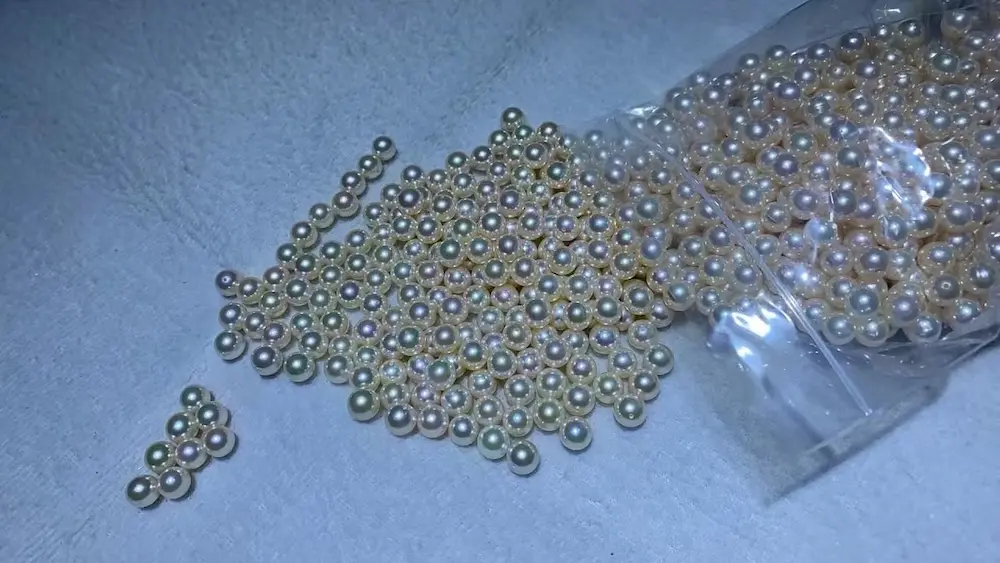
Akoya pearls usually range from 6mm to 9mm in size and come in classic colors like white, cream, and silver, often with subtle hints of pink or green. Because they have such a beautiful shine, they’re perfect for formal events and classic jewelry designs. Many Pearl Manufacturer consider Akoya pearls the benchmark for traditional elegance.
2. Freshwater Pearls: Nature’s Versatile Gems
Mussels that live in rivers, lakes, and ponds grow freshwater pearls, adding to the fascinating array of different types of pearls. China is the biggest producer of freshwater pearls, but Japan and the United States also grow them. Freshwater pearls are really cool because they come in so many different shapes, sizes, and colors.
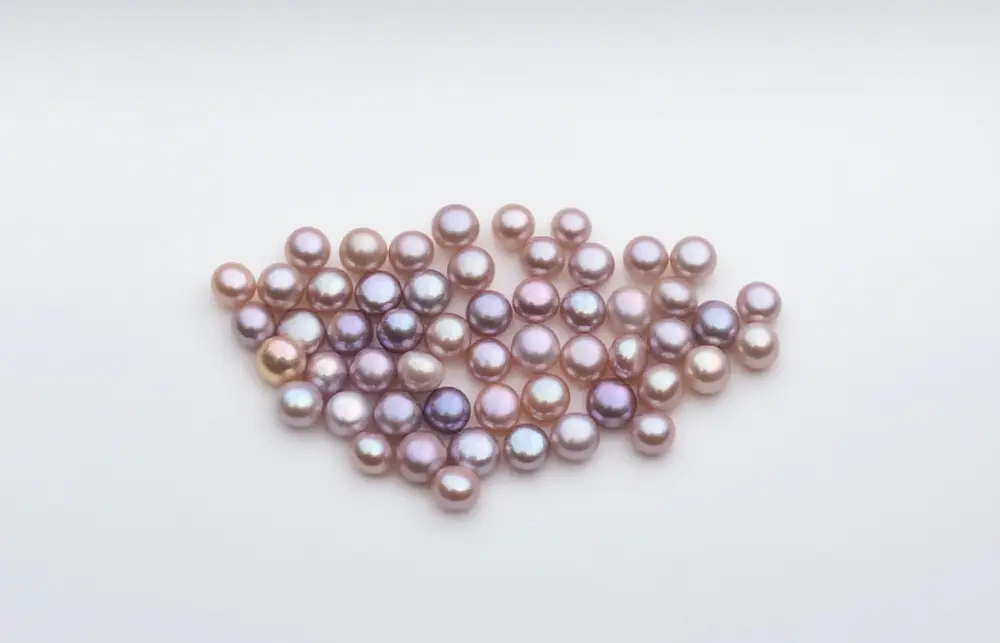
These pearls range in size from 2 mm to 15 mm across and are among the different types of pearls. They come in a naturally wonderful variety of colors—from the classic white and cream, to soft pastels like pink and lavender. You can even find rarer types in darker colors like purple, gold, and bronze.
Baroque Freshwater Pearls: The baroque type of freshwater pearl is very interesting. These are all about celebrating shapes that are natural and not perfect, which can be very artistic and one-of-a-kind. Baroque freshwater pearls are all different because they have really cool surface textures and shapes that look like they came from nature. Their unique shapes make them great for modern jewelry designs, and they are usually cheaper than perfectly round pearls.
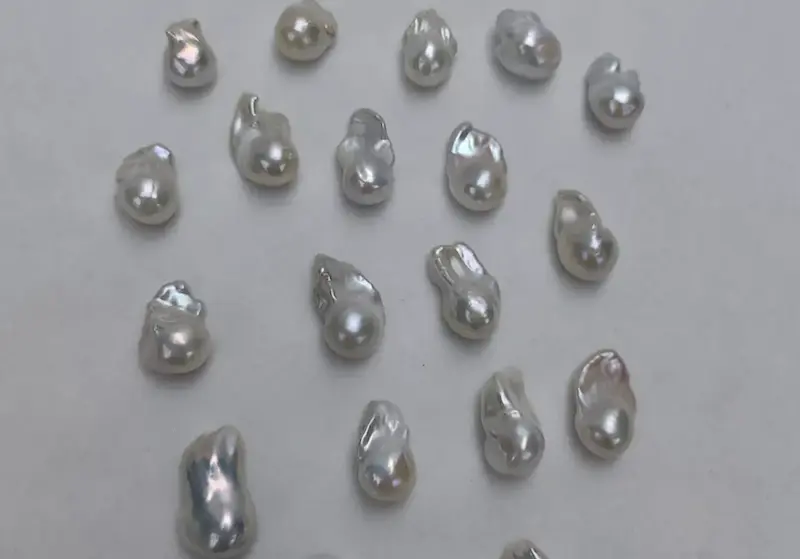
One of the best things about freshwater pearls is that they cost less than saltwater pearls. They are a great choice for everything from everyday jewelry to those really eye-catching statement necklaces.
3. Tahitian Pearls: The Dark Beauties
Among the different types of pearls, don’t be fooled by the name “black pearls”! Tahitian pearls come in a beautiful range of dark, dramatic colors. These exotic beauties are grown in the clear waters of French Polynesia. They can be deep charcoal, peacock green, rich purple, or even silver.
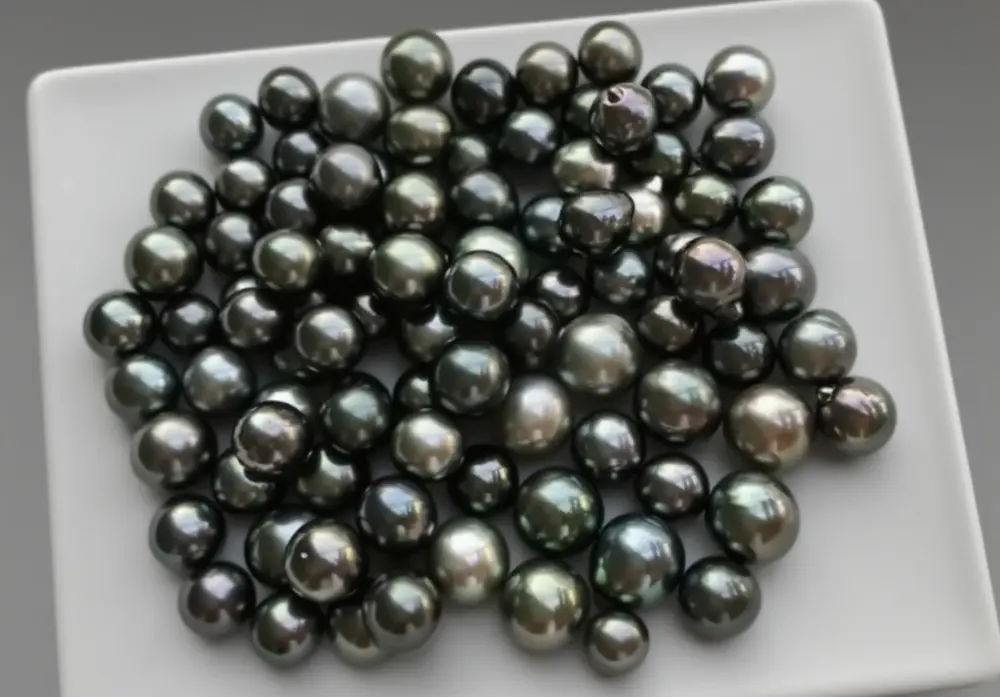
Among the different types of pearls, what really sets Tahitian pearls apart is their size and those amazing colors. They usually measure between 8 mm and 14 mm, making them noticeably bigger than Akoya pearls and giving them a totally different look. Those naturally dark shades come from the black-lipped oyster they grow in, giving the pearls an air of mystery and elegance.
These gems are perfect for those who want to make a statement. Tahitian pearls can seamlessly integrate into both minimalist modern designs and traditional styles.
4. South Sea Pearls: The Giants of the Pearl World
South Sea pearls are the biggest and rarest of all the cultured pearls you can find among the different types of pearls. They’re grown in the warm waters around Australia, Indonesia, and the Philippines. These beauties can get as big as 20 mm or more, which is really cool!
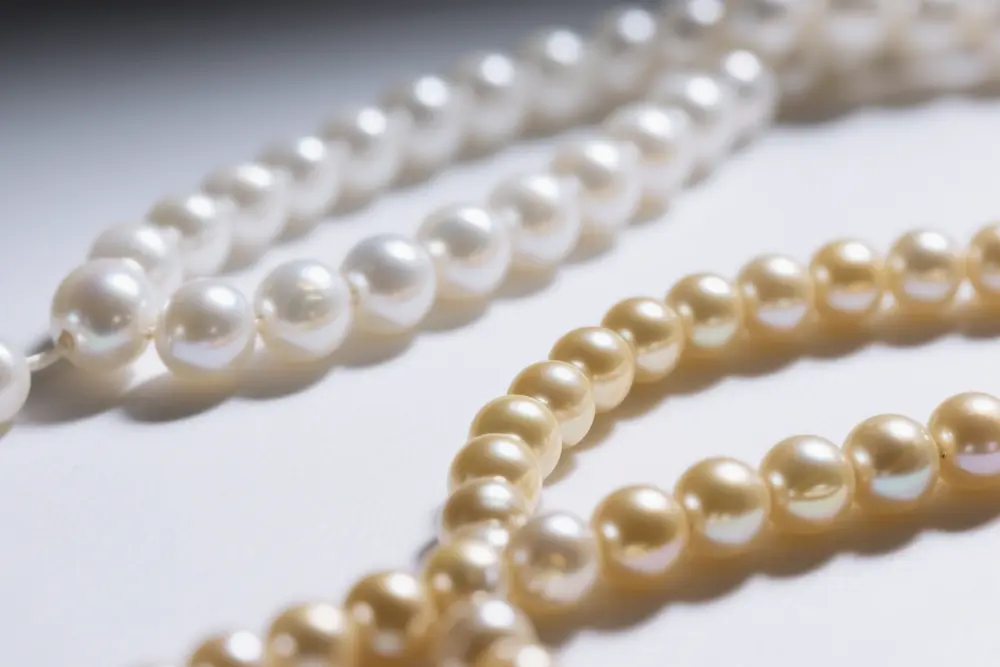
There are two main types of South Sea pearls. It takes about two to four years for Pinctada maxima oysters to grow them.
White South Sea Pearls: These are beautiful, with colors that range from bright white to soft cream or silver. Because they’re so big and glowy, they’re some of the most desired pearls around. You’ll mostly find them grown in Australia and Indonesia, using silver-lipped oysters.
Golden South Sea Pearls: These might just be the rarest of all cultured pearls! They come in shades from light champagne to a rich, deep gold. The stronger the gold color, the more valuable they are, with the deepest golden colors being the most expensive. These are mostly grown in Australia and the Philippines using gold-lipped oysters.
Both the white and golden types are known for being impressively large (usually 10-20mm), incredibly beautiful, and quite rare. That’s why they’re some of the most sought-after gems for jewelry!
5. Keshi Pearls: Nature’s Happy Accidents
Among the different types of pearls, Keshi pearls are kind of a happy accident in the cultured pearl world. They pop up when the oyster rejects the little bead that’s usually put in to start the pearl-making process. But instead of giving up, the oyster keeps making nacre (that shimmery stuff that makes up a pearl). This results in a pearl that’s all nacre, with a cool, irregular shape. Because they’re solid nacre, Keshi pearls are super shiny and totally one-of-a-kind.
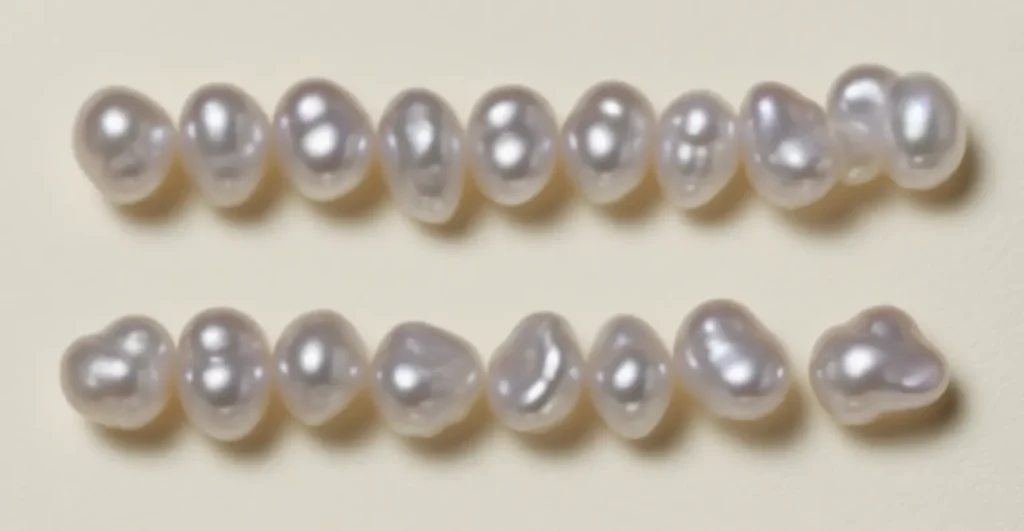
These “poppy seed” pearls (that’s what “keshi” means in Japanese) are a great deal for how pretty they are. Because they’re made entirely of that shimmery nacre, they often have an even brighter shine than regular pearls of the same kind. They can pop up in both saltwater and freshwater, which means you can find them in lots of different types.
6. Mabe Pearls: The Half-Round Wonders
Among the different types of pearls, Mabe pearls (also called blister pearls) grow differently. Instead of floating freely inside the oyster’s shell, they are attached to the inside of the shell. This gives them a half-round or dome shape, which is perfect for jewelry like earrings, rings, and pendants. The flat back makes them easy to attach!
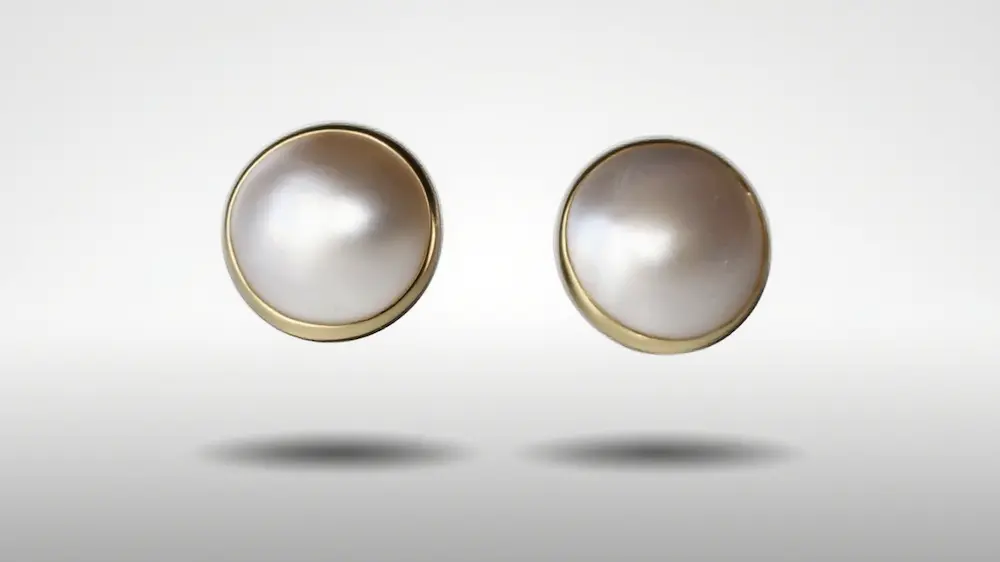
These pearls are a great way to get the look of larger pearls without breaking the bank. They’re especially popular in modern jewelry designs. You can find them in all sorts of colors, and they’re grown in both saltwater and freshwater.
7. Conch Pearls: The Natural Rarities
Conch pearls are very rare and special among the different types of pearls. You won’t find many pearls like these. These pearls are real, unlike other pearls that can be grown or farmed. These amazing gems grow inside Queen Conch mollusks (Strombus gigas) in the Caribbean Sea.
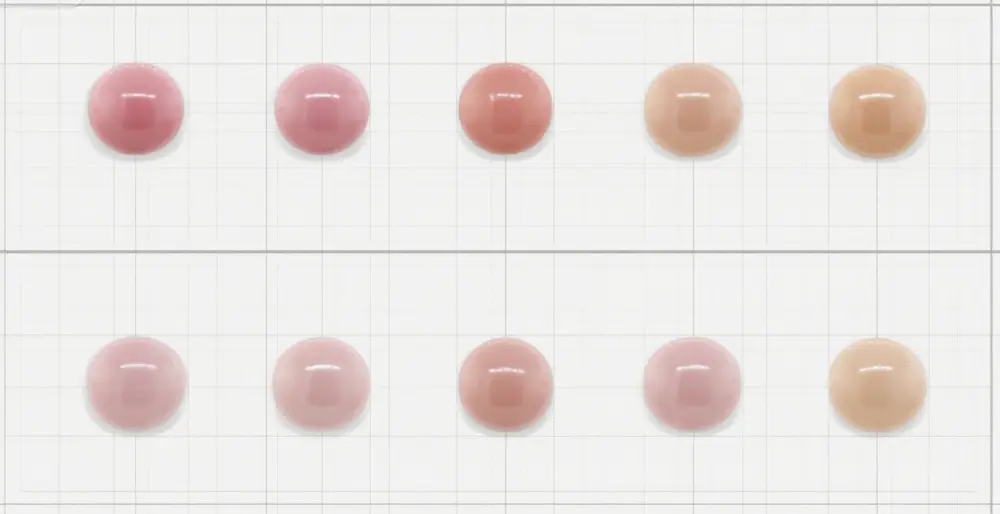
What makes conch pearls stand out is their cool flame-like pattern on the surface and their colors, which range from white and yellow to really vibrant pinks and oranges. The most valuable ones have a deep pink color and a really noticeable flame pattern. Because they’re so rare and can’t be cultured, conch pearls are super expensive in the jewelry world.
| Pearl Variety | Origin | Size Range | Primary Colors | Distinctive Features |
|---|---|---|---|---|
| 1. Akoya | Japan, China | 6-9mm | White, cream, silver | Perfect roundness, mirror luster |
| 2. Freshwater | China, Japan, USA | 2-15mm | Full spectrum | Most variety in shapes and colors |
| 3. Tahitian | French Polynesia | 8-14mm | Black, gray, peacock green | Natural dark colors, exotic appeal |
| 4. South Sea | Australia, Indonesia, Philippines | 10-20mm+ | White, cream, silver, gold | Largest cultured pearls, satiny luster |
| 5. Keshi | Worldwide | 2-12mm | Various | All-nacre composition, intense luster |
| 6. Mabe | Worldwide | 10-20mm | Various | Half-round shape, practical mounting |
| 7. Conch | Caribbean | 2-20mm | White, yellow, pink, orange | Natural only, flame pattern, extremely rare |
How to Choose the Right Pearl Type for You
There are a lot of different types of pearls to choose. But if you consider your style, budget, and how you prefer to use them, it can help you narrow down your options.
- For Classic Elegance: Variety #1 (Akoya pearls) is the best choice for classic elegance. It’s great for both business and formal events. They are great for any event because they look classic and shine like crazy.
- For Making a Statement: Variety #3 (Tahitian pearls) is great for people who want their jewelry to stand out and be remembered because they are bigger than most and come in unusual colors.
- For Investment and Luxury: Variety #4(The golden South Sea pearls) is the most expensive. They are great investments that can be passed down from generation to generation because they are rare, big, and beautiful.
- For Everyday Wear and Versatility: Variety #2 (freshwater pearls) has the most choices at the best prices. You can make a lot of different collections without spending a lot of money because they come in so many colors, shapes, and sizes, even baroque ones.
- For Unique and Artistic Pieces: If you like jewelry that is one-of-a-kind and celebrates natural beauty and imperfection, you might want to look at Variety #5 (Keshi pearls) or Variety #6 (Mabe pearls).
- For Ultimate Rarity and Collectors: Variety #7 (Conch pearls) are incredibly rare. They’re perfect for serious collectors who love natural, uncut gems that have a story to tell.
Pearl Quality Factors: What to Look For
Regardless of which types of pearls you choose, understanding quality factors will help you make the best selection:
- Luster: Luster is the most important quality factor. High-quality pearls should have a mirror-like surface that clearly reflects light and images. This inner glow is what gives pearls their captivating beauty. According to the Gemological Institute of America (GIA), luster is evaluated by the sharpness and intensity of reflections from the pearl’s surface.
- Surface Quality: Surface Quality affects both beauty and value. When you’re checking out pearls, try to find ones that have as few blemishes, spots, or uneven patches on the surface as possible.
- Shape: Everyone has their own taste when it comes to shape. But generally, perfectly round pearls are considered the most valuable. After that, you have near-round, oval, and then the more free-form baroque shapes.
- Size: Generally speaking, bigger pearls are worth more. That’s because they’re harder to come by, especially the saltwater kind.
- Color: When it comes to color, look for pearls with an even shade that you personally find attractive. Keep in mind that some colors are harder to find than others, and that will affect how much they’re worth.
The Pearl Market: Trends and Considerations
The pearl world keeps changing, with new ways to grow different types of pearls and fresh designs popping up all the time. Nowadays, people really want to know where their jewelry comes from, and that’s making cultured pearl farming, as a sustainable practice, more and more appreciated.
A lot of folks are surprised to hear this, but pearl farming can actually be good for the ocean! Pearl farms work hard to keep the water clean, and they often act like safe places to swim. This helps all kinds of sea life live and grow.
When you want to wholesale pearls , it’s best to go to a pearl dealer that has been around for a while and is known to be honest.
Caring for Your Pearl Collection
It’s not too hard to take care of different types of pearls, but knowing what each kind needs will help them stay beautiful for a long time.
Pearls are organic gems, and they aren’t as hard as other gems. They only get a 2.5 to 4.5 on the Mohs hardness scale. Because they’re delicate, you’ll want to handle them with care and store them properly to avoid scratches and damage.
- Storage: When you’re storing your pearls, keep them away from harder gemstones and metals. Soft pouches or jewelry boxes with a lining work best to protect them.
- Cleaning: For cleaning pearls, mild soap and warm water are your best bet. Just a heads up: ultrasonic cleaners, steam cleaning, and strong chemicals are a no-go for pearls. They can really mess them up.
- Wearing: Put pearls on after applying cosmetics, perfume, and hair products. These substances can damage the pearl’s surface over time.
- Professional Care: It’s a good idea to get your pearl jewelry professionally cleaned and restrung every now and then, especially if you wear it often. This will help them look their best!
FAQs
What are the different types of pearls?
Main ones: freshwater, Akoya, Tahitian, and South Sea—each from a different mollusk and price zone.
What is the most expensive type of pearl?
Natural South-Sea gold or white rounds—big, rare, and priced like small cars.
What is the highest quality pearl?
Top-grade “AAAAA” Akoya or “Gem” South-Sea: mirror-shine, almost flawless, and perfectly round.
What are cheap pearls called?
Fashion or “shell” pearls—coated beads that look the part but cost pocket-money.
In the end: The world of different types of pearls offers something for everyone, from the budget-conscious jewelry lover to the serious collector seeking investment-grade gems. Jewelry is special because each type of pearl has its own beauty, history, and personality.
You can pick pearls that you will love for a long time if you know the differences between Akoya pearls, Tahitian pearls, South Sea pearls, and freshwater pearls.
The “best” pearl is the one that makes you the happiest every time you wear it.When you look at different types of pearls for your collection, take a moment to learn where they come from, appreciate their natural beauty, and think about how each one fits your style. There is a perfect pearl out there for you; you just have to find the one you love.
The trip to the world of pearls is just as beautiful as the pearls themselves. Start to see what has made jewelry lovers happy for thousands of years, as you discover different types of pearls. You can choose each pearl to tell your own story. This connects you to the old tradition of these ocean treasures and shows off your own style and personality.

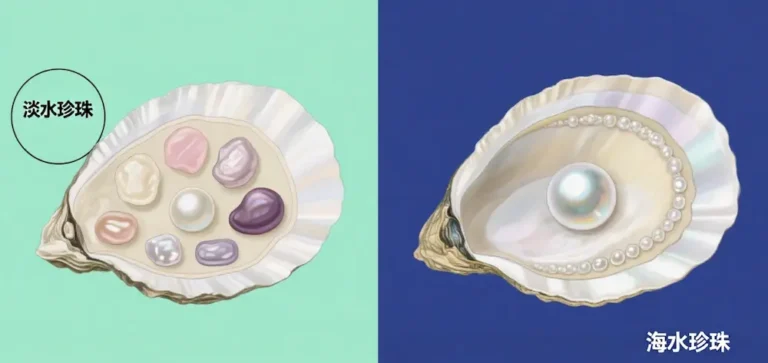
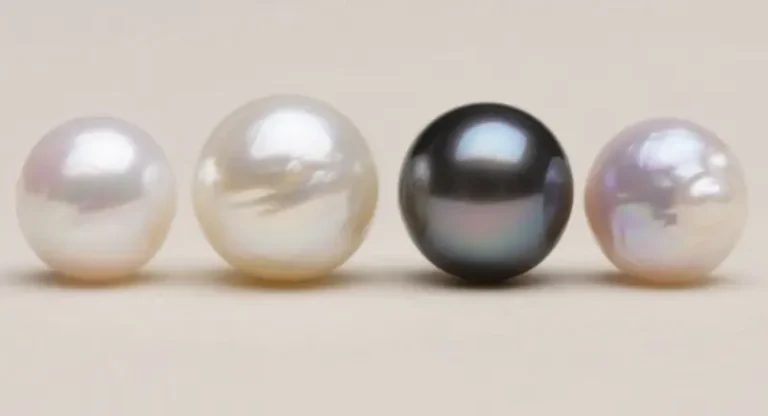
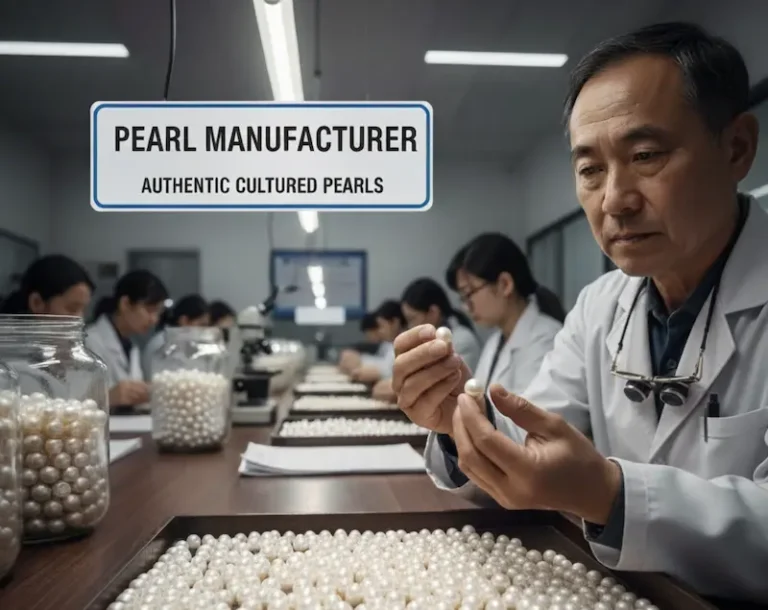



One Comment